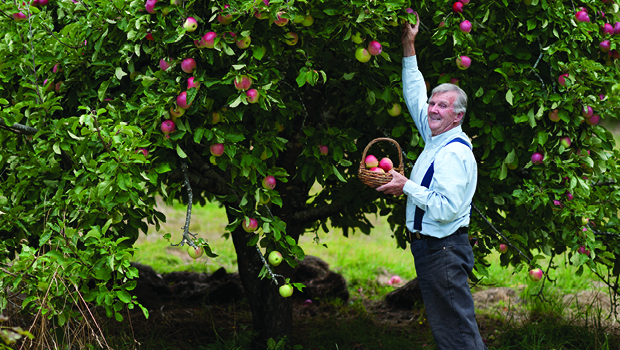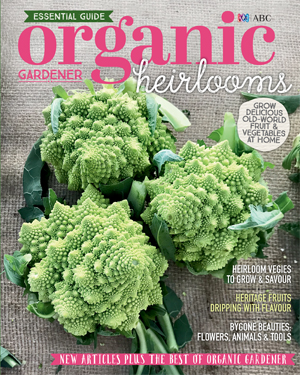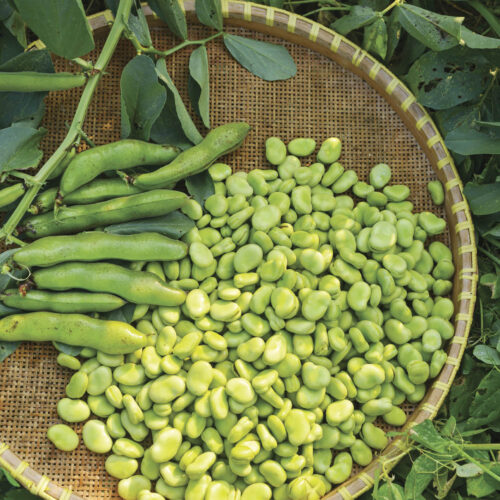Apple of Peter’s eye
2018-08-06T05:14:15+10:00
In Australia we can grow heritage apple trees from the subtropics to the snow, although most varieties grow and fruit better in cooler regions. Here's some favourites to try.
I can easily recall the very first time I tasted an apple. It was Christmas morning, just a few months before my fourth birthday. My brother and I scrambled to open the filled stockings we found hanging over the end of the bed we shared.
Each stocking contained a new penny, some dried figs, a tiny Fry’s Chocolate Cream bar, two Brazil nuts, a ‘Jaffa’ orange and a deep red, shiny apple. Unused to sugar, we found the chocolate too sickly sweet, but I’ll never forget that amazing apple.
I scoffed the lot, even sucking out all those tiny, juicy bits deep within the core. I even chewed the base of the stalk. That was way back in 1931 and I’ve been addicted to apples ever since.
In those poverty-stricken days apples were a rare luxury, especially in winter. As a child I was unable to resist secretly salvaging and enjoying even half-eaten apples or fat cores I came across lying in the street.
When I was seven years old I stole my first apple from the front of our local greengrocer’s shop. Clearly he saw me, but was a kind man. As I passed a week later, he came out and sadly gave me a large apple. Out of shame I never walked past again, always taking an alternative route to school. Oddly enough, in 2007 at the age of 80 I re-visited the area. The greengrocer’s shop had long gone but while passing the empty site I was astonished to experience a re-emergence of that same sense of guilt.
An apple a day
When I was a child I was clearly unaware that my real craving and need was for the minerals and vitamins contained within apples – not just the taste. Although 85 per cent water, apples also contain an extraordinary range of essential nutrients. Nutritionists have long pointed out that regular exercise, coupled with a balanced diet of vitamin-filled fresh food can not only help reduce obesity and blood-pressure problems, but provide powerful resistance to many modern diseases. For me, raw apples eaten with their skins are a major source of roughage and I’m sure they have helped me stay marvellously healthy all these years.
Apples are by far the most popular of all fresh fruit around the world, where they are available. In fact, there are more than 7000 grown cultivars including dessert, cooking, cider and crab apples.
Growing conditions
In Australia we can grow heritage apple trees from the subtropics to the snow, although most varieties grow and fruit better in cooler regions. This is because like fruit buds on many other deciduous fruit trees, those on apple trees usually fail to produce fruit unless chilled during winter dormancy. Most apple varieties need at least 1000 hours during which temperatures drop below 7°C. This is easily achieved in most parts of southern Australia.
However, there are several low-chill varieties (300–400 hours) specially bred for the subtropics. They include ‘Anna’, ‘Tropic Sweet’ and ‘Rome Beauty’, which dates from 1848. The outstanding ‘Dorsett Golden’ actually produces excellent yields after only 100 hours below 7°C. ‘Dorsett Golden’ is named for a Bahamas resident, Irene Dorsett. It was discovered in 1953 and introduced in 1964.
The range of varieties on offer, especially during winter is enormous. In fact, it is possible to select several varieties so you have non-stop supplies of eating or cooking apples for harvesting from late December through to late July. And most late-season apples, including cider and crab apples, can be cool-stored without need of refrigeration until October or even later and still remain in good condition.
PETE’S (ALMOST) YEAR-ROUND APPLE PICKS
In my experimental Tasmanian garden I’ve planted a wide mixture of early to late-season heritage favourites. All bear excellent apple crops from late December to mid-July, with enough long-keepers for storage until November. They include multi-grafts, espaliers, dwarfs and full-sized trees providing all the apples we can eat, give away or store through summer, autumn, winter and early spring. Below are my favourites listed under harvest times.
Late December-February
‘Gravenstein’ – An old heritage cultivar still grown commercially. Sweetly crisp fruit, with some ripe around Christmas through to February.
‘Akane’ – Originally from Japan in 1970, originating from a 1937 cross between ‘Jonathon’ and ‘Worcester Pearmain’. Deep red skin, juicy sweet flesh.
March-April
‘Cox’s Orange Pippin’ – An English variety about 200 years old, developed from a seedling of ‘Ribston Pippin’. By far the best-flavoured, most aromatic eating apple.
‘Bramley’s Seedling’ – Early English cultivar from the second decade of the 1800s, still the UK’s most popular cooking apple. The perfect cooker – flesh turns creamy yellow and deliciously fluffy.
‘Golden Delicious’ – Developed from a chance seedling found in 1890 in West Virginia, USA. Outstanding flavour with heavy crops even on young trees.
‘Pomme de Neige’ – Of French heritage, the name translates as ‘Snow Apple’. Red skin, dazzling white flesh, juicy and sweet.
‘Jonathan’ – Originally from the USA in 1826, and registered on the National Apple Register, UK, in 1971. Great crops of sweet red fruit but vulnerable to powdery mildew attack unless tip-pruned in winter.
April-May
‘Pine Golden Pippin’ – A very early English apple from about 1860. A dull green, insignificant-looking heirloom but my own all-time favourite for eating fresh. Cream-coloured flesh, highly aromatic and utterly delicious.
‘Alexander’ – Originally from Russia, but grown in the UK from 1805. Huge, lightweight, sweetly flavoured apple.
‘Catshead’* – Very early English cultivar probably dating from the 1600s. Another great heirloom cooker. Big, heavy, dense apples on a vigorous, disease-resistant tree.
May-June
‘Egremont Russett’ – Probably dating from the 1870s, this is one of Britain’s most popular heritage heirloom eating apples. Dull green, heavily russetted but thin edible skin. Brilliant sub-acid sweet flavour.
‘Mutsu’ – Known as ‘Crispin’ in the UK, this Japanese cultivar is from relatively recent breeding. Apples look like giant ‘Golden Delicious’. Soft lemon- yellow with wine-like flesh.
June-July
‘Red Fuji’ – Developed in Japan in the 1930s, came to Australia in the 1960s. Heavy crops of rich red fruit with creamy white, sweetly crisp flesh. Great for storing.
‘Granny Smith’ – From a chance seedling from a tree grown by Mrs Thomas Smith of Ryde, NSW, 1868. Australia’s great contribution to the apple world. Suitable for desserts or cooking. Fruit hangs well into winter.
‘Sturmer Pippin’ – Outstanding heritage variety from Sturmer in Suffolk, England, 1831. Resistant to woolly aphid attack. Develops an extraordinary crisp, juicy sweetness after 1–2 weeks in storage.
For all Pete’s tips on growing the best apples, you can get a digital copy of ABC Organic Gardener Essential Guide: Heirlooms here.







